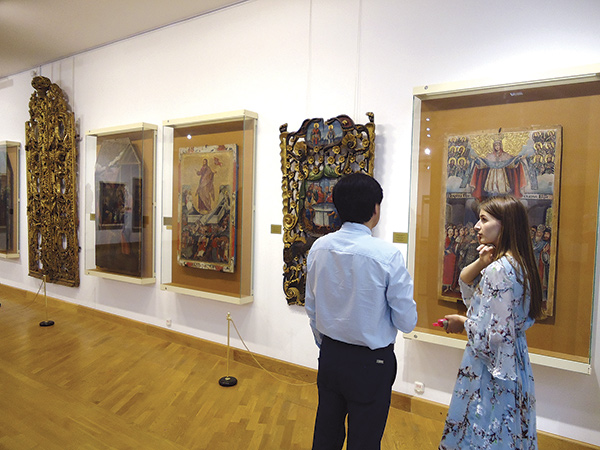
Foreign guests at National Art Museum
The Belarusian images of saints, synthesising the culture of the Catholic West and Orthodox East, are unusual, notes the National Art Museum Deputy Director General for Research, Natalia Selitskaya. She tells us, “The idea of showcasing Belarusian icons at the Vatican appeared nine years ago, so we’ve been preparing the exhibition for a long time. We selected icons from the museum collection (from about a thousand), and conducted restoration. First, we planned to send large-sized works to Italy, but the hall allocated wasn’t spacious enough so, we had to choose exhibits more suited to the space. We sought to show the diversity of our national painting school. Belarusian icon-painting differs greatly from Byzantine and Russian. Our masters would often decorate the background with carved ornamentation, preferring solidity to delicacy. The themes also differ, as the Italians note.”

Artefacts that dazzle
Ms. Selitskaya continues, “To emphasise the links between traditions and innovation, along with the old icons, we sent two pieces created by contemporary master Andrey Zharov. After the Vatican display, we plan to show the icons at our museum. The Minsk exhibition will be larger, as it will encompass artworks shown in Italy and those that weren’t.”
 Belarusian icons were exhibited in Italy in 2004 and 2005, at galleries in Milan and Trieste. Those exhibitions also aroused huge interest from the Italian public, revealing shared European artistic canons, inherited from Byzantine traditions.
Belarusian icons were exhibited in Italy in 2004 and 2005, at galleries in Milan and Trieste. Those exhibitions also aroused huge interest from the Italian public, revealing shared European artistic canons, inherited from Byzantine traditions.
About two million people have visited this year’s exhibition of Belarusian icons at the Vatican, which was displayed in one of the Pinacoteca halls, close to 11th-16th century Byzantine, Greek and Italian icons. Visitors were able to see how Belarusian icon-painting originated from early Christian culture. Multi-lingual notes written in the guestbook — expressing gratitude to organisers, admiration of Belarusian iconographers’ mastery and discovery of a new field of culture — confirm huge interest in the exhibition.
National Art Museum staff, headed by Deputy Director General Sergey Vecher, who came to disassemble the exhibition, have visited the restoration workshops of the Vatican, learning about the work of tempera and oil painting, multi-coloured sculpture, artistic fabrics and graphics restorers. Piotr Beresh, a doctor of theology, accompanied the visitors. Italian experts shared their methods of research and explained the materials and techniques used. An agreement has now been reached to arrange training for our restorers at the Vatican museums.
The Belarusian icons have returned to Minsk by special transport. In September, they’ll be shown in an expanded exhibition entitled Heavenly World on Earth, at the National Art Museum.
By Vladimir Velikhov











